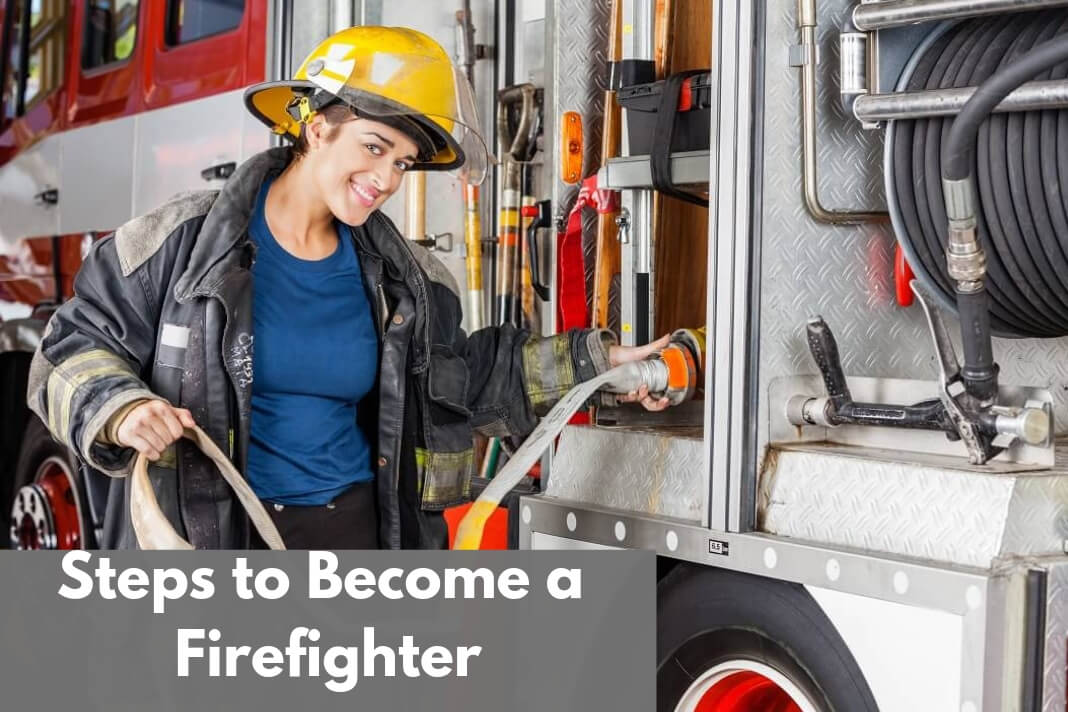
Firefighter career is very competitive and the road to becoming a firefighter is not an easy one. Firefighters are trained to fight in all climatic conditions and environment – forests, rural area, to urban localities – their duty lies in putting their own lives and services forward to protect lives first and then properties. To become a firefighter you need to work hard, get trained for long hours, make your reflexes strong, and become selfless.
If you are on this page, you are most likely planning to become a firefighter, and looking for more information regarding the career. We have broken down the steps to become a firefighter and shared information about the profession. This article will help you prepare to join the fire service. The first step should be understanding the types of job opportunities in a firefighting career, and what each job entails.
Firefighter Career Overview
Firstly, you can use one of the two ways to become a firefighter – by working your way up the ladder by volunteering at the local firehouse, coupled with high school diploma or a bachelor’s degree or by getting a fire science degree to advance your ranks and prepare for the state or federal level.
Firefighters work at a variety of emergency situations. Although they work on stopping the fire from spreading, they are also ushered to handle medical situations, such as rescuing injured and treating them and educating the public on disaster management. Therefore, you will receive expert training on several other subjects, apart from fire management.
As a firefighter, you have to be always ready to be called at all hours. Just like medical professionals, there is no on or off duty. You may also have to respond to calls from your home during off duty hours. However, most firefighters stay on firehouses during their shifts to act upon emergency calls faster, especially in the urban areas.
As a firefighter, you will fight active fires, rescue individuals from buildings that caught fire and make emergency medical calls because of injuries and accidents.
Apart from these forefront jobs, you will also perform a lot of behind-the-scenes works like maintaining fleet of emergency vehicles, practicing safe driving techniques, educating and training subordinates, implementing preventive fire maintenance, working closely with federal, local and state officials at various events, patrol suspicious and red alert areas, and work on physical fitness and mental strength.
As you move up the rank, you will get more responsibilities. While you will be recruited as a probationary firefighter at the start of your career, you might reach the top level of Fire Chief with dedication and knowledge.
In the US itself there are around 3,00,000 professional firefighters working day and night, and around 90% of them work with the local government. The salary of firefighters varies widely across the world. Professionals working in urban areas get better financial coffers, while firefighters working with small departments with a limited budget are paid less.
Firefighters are always in demand for they work for community safety and security.
Steps To Become A Firefighter
Step 1: Become Eligible
To become an eligible candidate, you must be at least 18 years old. However, in some states, the minimum requirement is 21 years. On the other hand, you can start your on-the-job training before you turn 18, probably in your high school days.
Firefighters must have a basic high school degree or an equivalent degree and a valid driving license. There is an age limit for entrance as well, usually, it is between 28 and 30 years old. You must be physically fit and lead a healthy and crime-free life for you will be required to pass a drug screening and criminal history record check.
Step 2: Firefighter Volunteer For The Trade
One of the best people to learn about firefighting trade is contacting a local expert. They will suggest you start as a volunteer. Most firefighting departments often have openings for people to a vast range of services, including for the community. For instance, you may help the staff at a local community event or fair. Volunteering proves to be beneficial in many ways, including connecting and networking with professional people in the field,firefighter job opportunities, and of course, a first-hand experience.
Step 3: Get Fit
Since you will be usually working for long hours under stressful conditions, you have to be physically fit more than most professionals from other careers. You will have to climb difficult terrains, and scale buildings faster, dig deep into fallen earth to rescue people, and perform other stunts, such as jumping from one building to another.
Moreover, to qualify as a suitable candidate, you must pass a very strenuous physical examination at the time of application. Therefore, you should start your process by becoming physically fit. Find agencies that offer CPR training. The Red Cross offers this kind of training and holding a Red Cross can elevate your chances of working with firefighting team upfront or handling duties around the station.
To make your credential stronger, you can take a full EMT training while working as a volunteer. EMT license is mandatory in some jurisdictions. So it becomes compulsory for firefighter applicants to get the license in such case. With an Emergency Medical Technician (EMT) license, you will be eligible to work on emergency medical situations. The licensing is a multi-level process. However, since the requirement varies in each country, you may want to find out from your local state of federal authorities.
Step 4: Get The Fire Science Degree
Though a great deal of training is done at the firehouse, having a degree in fire science definitely increases the chance of being hired by reputed organizations with a good pay scale. Typically, organizations prefer newly recruits who have a combination of volunteering work and practical firefighting experience with a post-fire training at an institution.
So, your degree program will entail lessons on different firefighting technology programs that help students become firemen, fire investigators, fire inspectors, and fire arson investigators. You will also be learning to:
- Extinguish or suppress fire with hoses, pumps, and other apparatus.
- Climb structures, including buildings, balconies, rooftops, windows, etc.
- Evacuate fire-caught structures and help victims.
- Treat victims with medical aids.
- Drive and operate emergency vehicles and engines.
- Look after firefighting equipment.
- Educate the public by demonstrating different disaster management hacks.
- Educate on topics that may not be covered by firehouse training, such as hazardous materials control or anti-arson techniques.
There are associated bachelor’s degree programs at colleges and trade schools for those who want to go into careers of paramedics and leadership duties within firefighting agencies. Some fire organizations host accredited 4 years apprenticeship programs that cover everything mentioned above. You can also get a degree in forestry with environmental focus or firefighting and pursue this career.
Step 5: Take Examinations
Most often hiring organizations participate in recruitment programs when looking for eligible candidates. Don’t miss out on these events happening in and around your area. Typically, in the screening process, you will have to take physical tests (Candidate Physical Ability Test) and written tests. You may also have to participate in an oral interview, physical examination, aptitude test, and go through a background check and drug test.
You will be required to provide a detailed history of your previous job, academic record, credit history, and references list.
Typically, the written examination covers 100 multiple-choice questions on human relations, problem-solving, written and oral communication, basic mathematics and algebra, mechanical reasoning, logic, observation, and judgment, and error checking. The physical examination (CPAT) covers hearing test, eyesight test, blood pressure, blood, urine, and cardiovascular test, such as distance running, climbing flights of stairs, and lifting and carrying heavy objects. You will also be giving a psychological test that entails personality and behavioral test pertaining to roles of a firefighter.
Your oral interview will be similar to something like other job interviews where the interviewer will see your keenness, your vision, goals, and your answers and your communication.
It is not that local departments will be the only people hiring you; in fact, you can take jobs with the forestry firefighting department, state fire organizations, fire equipment manufacturers and suppliers, and with the construction industry.
Some agencies may send you to state, local or federal firefighting academy that adheres to a specific country’s fire administration guidelines. In the US, the National Fire Protection Association also offers a certification course for aspirants, which is typically 110 hours long.
Step 6: Train And Work At Fire Organization
Once you are hired, the fire organization will teach you different types of fire and ways to extinguish them. You will also learn to operate and use different equipment and tools, such as an ax, ladder, saw, hose, pump, etc. Your training process will include the following:
- Firefighting techniques
- Fire prevention methods
- Hazardous materials control
- Emergency medical procedures
- Building codes to provide fire inspections
- Methods, process, and hacks to carry out rescue operations
- Handling hazardous materials
Thereafter, you will be placed in a fire department to gain practical experience with firefighters. This period may not be paid in most cases. However, some organizations do pay a small wage as an internship fee.
You have to continually educate and train. How much ongoing education a firefighter needs depends on their leaders and career paths. Keeping up the training is an essential part of the job.
Additional Information On This Career
- Ranking of firefighters starts from probationary firefighters to engineer, lieutenant, captain, battalion chief, assistant chief, deputy chief, and final, to the fire
Formal Education Options Include:
Vocational or Trade School – Entails certificate in fire science, fire protection, and emergency medical technician.
Military – Having trained under the military will give you comprehensive knowledge on handling various firefighting material, chemicals, compounds, tools, and equipment. Military training will also make you physically agile, lithe, and mentally sharp.
Master Program – It is for students who want to expand knowledge. They are 2 – 3-year programs, which can be studied online.
Four-year bachelor’s degree –Entails a college or university degree program that teaches candidates several related subjects, including management, business, and communication.
Community colleges– Two-year programs, which are typically associated degrees in fire science or fire technology.
Different Types Of Fire Science Degrees:
Certificate in Fire Science or FireTechnology – Provides students with basic knowledge about fire moves, feeds, tools and techniques. Also includes legalities, fire code enforcement, and investigation and analysis.
Associate Fire Science Degrees – It provides additional certification in a particular major, including terrorism management, hazardous materials awareness, vehicle extraction, urban interface operations, and vehicle extraction. You can specialize in any one of the above, along with your bachelor’s firefighter degree and become an expert professional.
Bachelor’s Degree in Fire Science – They are more elaborate and specialized, and allows students to concentrate on a particular aspect of firefighting. Entails fire and emergency administration, fire service human resource management, cooperative education, and fitness and physical conditioning.
Master’s Degree in Fire Science – It is for firefighters who want to enhance their skill and knowledge. The programs are offered online and include critical issues in security, fiscal financial management, dispute resolutions and negotiations, and advanced crisis management.
Careers In Firefighting:
You need not target to become a firefighter. In fact, there are numerous other professional specialties within the industry that can lead to fulfilling careers, which you can try. Options include firefighters, forestry fire prevention specialist, building inspector, paramedic, and arson investigator
[Also Read: How much you’ll make as a firefighter?]
Qualities Necessary For A Brilliant Firefighter:
You need to be courageous, risk taker, and selfless at helping others.
You should also be fearless to get involved with the unknown.
You must have great physical strength and endurance to be able to handle heavy equipment in adverse weather conditions.
You must be excellent in communication to be able to inform and communicate concerns accurately to the general public and people at stake.
You must be good at decision making because, in the event of emergencies and casualties, you must think pragmatically and make decisions quickly, even if the choices are difficult.
You must have good vision (20/20).
Hope our post helps you to take the right decision. Let us know what you chose to become in the comments below. You can also connect with us for more information.




